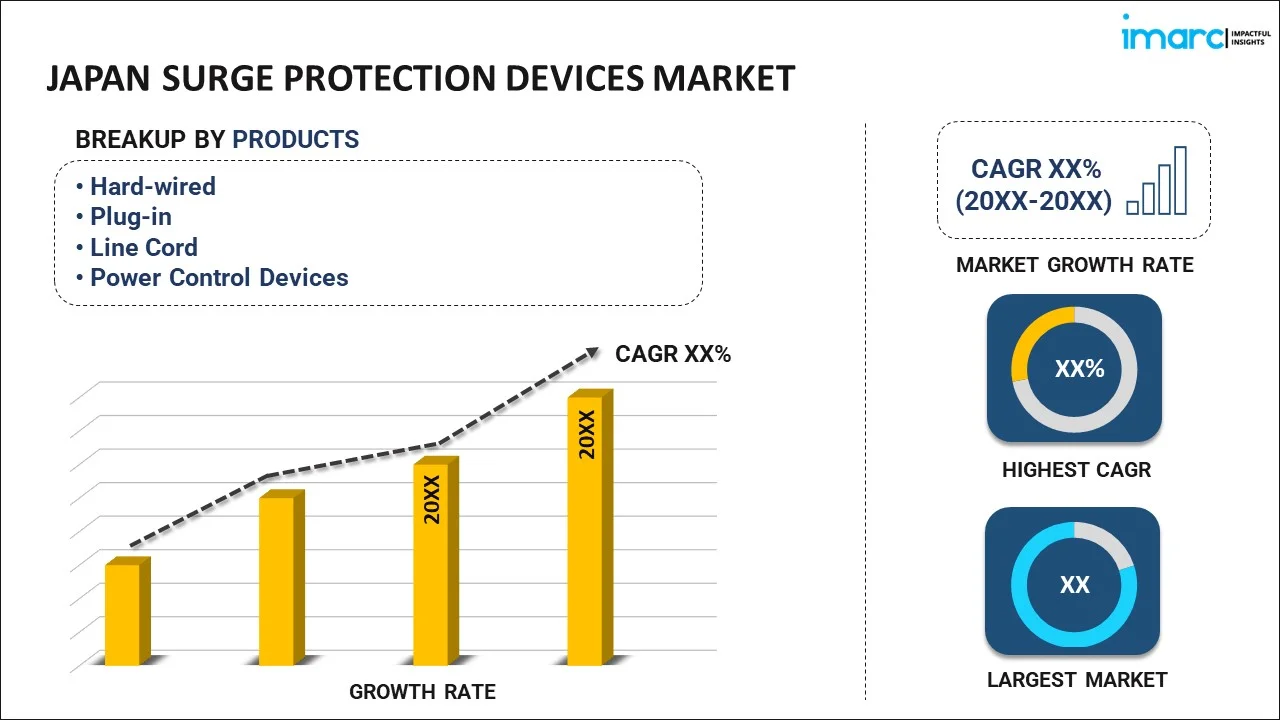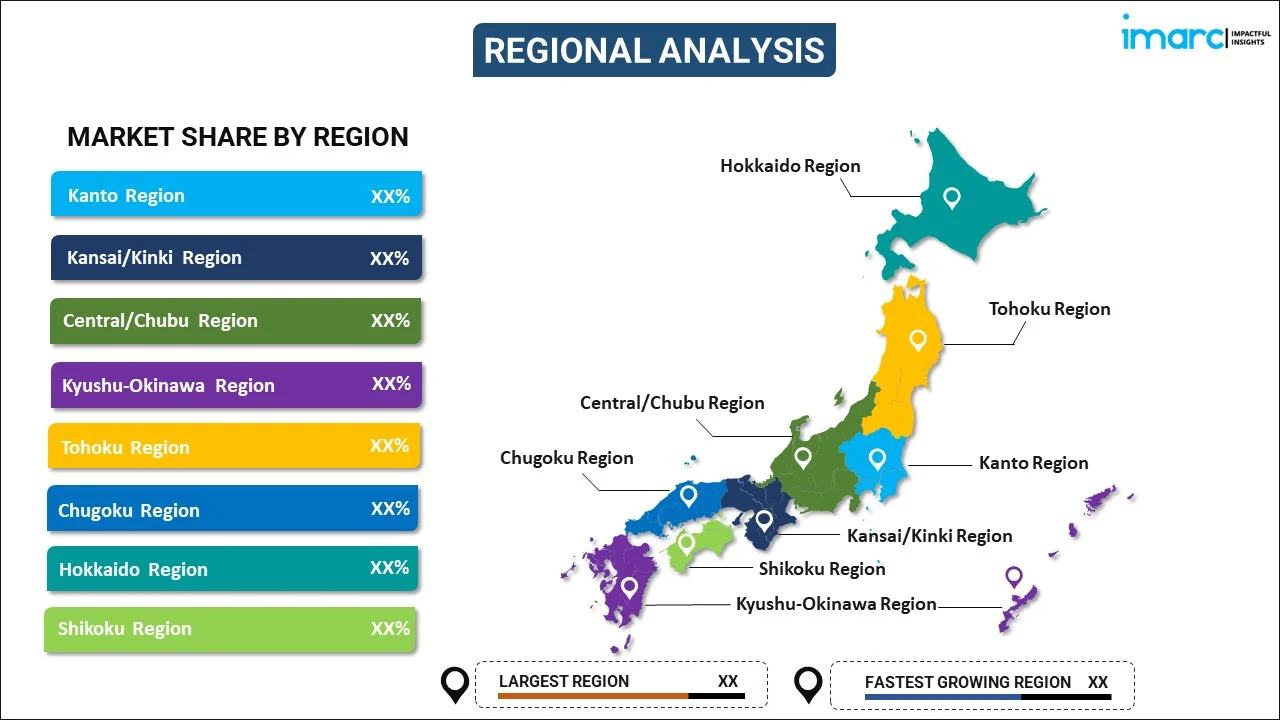
Japan Surge Protection Devices Market Report by Product (Hard-wired, Plug-in, Line Cord, Power Control Devices), Type (Type 1, Type 2, Type 3, Type 4), Power Rating (0-50 kA, 50.1-100 kA, 100.1-200 kA, 200.1 kA and Above), End User (Commercial Complexes, Data Centre, Industries and Manufacturing Units, Medical, Residential Buildings and Spaces, Telecommunication, Transportation, and Others), and Region 2025-2033
Market Overview:
Japan surge protection devices market size reached USD 124.9 Million in 2024. Looking forward, IMARC Group expects the market to reach USD 250.0 Million by 2033, exhibiting a growth rate (CAGR) of 7.5% during 2025-2033. The growing technological advancements in the electronics and semiconductor industries, the widespread adoption of surge protection devices in the healthcare industries, and the increasing product application in the renewable energy sector represent some of the key factors driving the market.
|
Report Attribute
|
Key Statistics
|
|---|---|
|
Base Year
|
2024 |
|
Forecast Years
|
2025-2033
|
|
Historical Years
|
2019-2024
|
| Market Size in 2024 | USD 124.9 Million |
| Market Forecast in 2033 | USD 250.0 Million |
| Market Growth Rate (2025-2033) | 7.5% |
Surge protection devices, or SPDs, are essential components in modern electrical systems designed to safeguard valuable electronic equipment and appliances from the damaging effects of voltage spikes or surges. These surges can occur due to various factors such as lightning strikes, power grid fluctuations, or switching of high-powered electrical devices within a facility. They act as a barrier, intercepting and diverting excessive voltage away from sensitive equipment, thereby preventing costly damage and downtime. They operate on a relatively simple principle and are installed at key points in an electrical system, typically at the service entrance, distribution panels, or directly at the equipment to be protected. Additionally, SPD quickly shunts the excess energy to the ground, effectively clamping the voltage to a safe level, and the process happens within microseconds, ensuring that the equipment remains unharmed. These devices are available in various types, including whole-house surge protectors, point-of-use surge protectors, and surge protector strips. Nowadays, surge protection devices are widely used in residential, commercial, and industrial settings to protect computers, televisions, HVAC systems, and industrial machinery across the country.
Japan Surge Protection Devices Market Trends:
The market is primarily driven by the growing technological infrastructure in the electronics and semiconductor industries. In addition, the proliferation of sensitive electronic devices and equipment in residential and industrial settings and the need to safeguard these assets against voltage fluctuations and transient surges are influencing the market growth. Surge protection devices are essential in preventing damage to electronics, thereby contributing to market growth. Moreover, the widespread adoption of surge protection devices (SPDs) in various industries where sensitive electronic equipment and systems are used represents another major growth-inducing factor. Besides this, the widespread adoption of surge protection devices in the healthcare industries to protect medical devices, diagnostic equipment, and IT infrastructure from power surges, ensuring patient safety and data integrity, is accelerating the product adoption rate. Along with this, the growing oil and gas industry is using surge protection devices to protect their control and monitoring systems from electrical disturbances and help maintain the safety and reliability of critical processes, propelling the market growth. Apart from this, the significant expansion in the information technology (IT) industry in data centers servers and networking equipment with SPDs installed at several points within data centers to protect servers, switches, and other critical infrastructure from voltage spikes and electrical surges to ensure uninterrupted operation and prevent data loss are augmenting the market growth. Furthermore, the growing renewable energy sector, such as solar panels and wind turbine installations, are susceptible to lightning strikes and electrical surges, resulting in the adoption of SPDs to protect inverters, control systems, and monitoring equipment in these installations, ensuring the reliable operation of renewable energy systems, creating a positive market outlook.
Japan Surge Protection Devices Market Segmentation:
IMARC Group provides an analysis of the key trends in each segment of the market, along with forecasts at the country level for 2025-2033. Our report has categorized the market based on product, type, power rating, and end user.
Product Insights:

- Hard-wired
- Plug-in
- Line Cord
- Power Control Devices
The report has provided a detailed breakup and analysis of the market based on the product. This includes hard-wired, plug-in, line cord, and power control devices.
Type Insights:
- Type 1
- Type 2
- Type 3
- Type 4
A detailed breakup and analysis of the market based on the type have also been provided in the report. This includes type 1, type 2, type 3, and type 4.
Power Rating Insights:
- 0-50 kA
- 50.1-100 kA
- 100.1-200 kA
- 200.1 kA and Above
The report has provided a detailed breakup and analysis of the market based on the power rating. This includes 0-50 kA, 50.1-100 kA, 100.1-200 kA, and 200.1 kA and above.
End User Insights:
- Commercial Complexes
- Data Centre
- Industries and Manufacturing Units
- Medical
- Residential Buildings and Spaces
- Telecommunication
- Transportation
- Others
A detailed breakup and analysis of the market based on the end user have also been provided in the report. This includes commercial complexes, data centre, industries and manufacturing units, medical, residential buildings and spaces, telecommunication, transportation, and others.
Regional Insights:

- Kanto Region
- Kansai/Kinki Region
- Central/ Chubu Region
- Kyushu-Okinawa Region
- Tohoku Region
- Chugoku Region
- Hokkaido Region
- Shikoku Region
The report has also provided a comprehensive analysis of all the major regional markets, which include Kanto Region, Kansai/Kinki Region, Central/ Chubu Region, Kyushu-Okinawa Region, Tohoku Region, Chugoku Region, Hokkaido Region, and Shikoku Region.
Competitive Landscape:
The market research report has also provided a comprehensive analysis of the competitive landscape. Competitive analysis such as market structure, key player positioning, top winning strategies, competitive dashboard, and company evaluation quadrant has been covered in the report. Also, detailed profiles of all major companies have been provided.
Japan Surge Protection Devices Market Report Coverage:
| Report Features | Details |
|---|---|
| Base Year of the Analysis | 2024 |
| Historical Period | 2019-2024 |
| Forecast Period | 2025-2033 |
| Units | Million USD |
| Scope of the Report | Exploration of Historical and Forecast Trends, Industry Catalysts and Challenges, Segment-Wise Historical and Predictive Market Assessment:
|
| Products Covered | Hard-wired, Plug-in, Line Cord, Power Control Devices |
| Types Covered | Type 1, Type 2, Type 3, Type 4 |
| Power Ratings Covered | 0-50 kA, 50.1-100 kA, 100.1-200 kA, 200.1 kA and Above |
| End Users Covered | Commercial Complexes, Data Centre, Industries and Manufacturing Units, Medical, Residential Buildings and Spaces, Telecommunication, Transportation, Others |
| Regions Covered | Kanto Region, Kansai/Kinki Region, Central/ Chubu Region, Kyushu-Okinawa Region, Tohoku Region, Chugoku Region, Hokkaido Region, Shikoku Region |
| Customization Scope | 10% Free Customization |
| Post-Sale Analyst Support | 10-12 Weeks |
| Delivery Format | PDF and Excel through Email (We can also provide the editable version of the report in PPT/Word format on special request) |
Key Questions Answered in This Report:
- How has the Japan surge protection devices market performed so far and how will it perform in the coming years?
- What has been the impact of COVID-19 on the Japan surge protection devices market?
- What is the breakup of the Japan surge protection devices market on the basis of product?
- What is the breakup of the Japan surge protection devices market on the basis of type?
- What is the breakup of the Japan surge protection devices market on the basis of power rating?
- What is the breakup of the Japan surge protection devices market on the basis of end user?
- What are the various stages in the value chain of the Japan surge protection devices market?
- What are the key driving factors and challenges in the Japan surge protection devices?
- What is the structure of the Japan surge protection devices market and who are the key players?
- What is the degree of competition in the Japan surge protection devices market?
Key Benefits for Stakeholders:
- IMARC’s industry report offers a comprehensive quantitative analysis of various market segments, historical and current market trends, market forecasts, and dynamics of the Japan surge protection devices market from 2019-2033.
- The research report provides the latest information on the market drivers, challenges, and opportunities in the Japan surge protection devices market.
- Porter's five forces analysis assist stakeholders in assessing the impact of new entrants, competitive rivalry, supplier power, buyer power, and the threat of substitution. It helps stakeholders to analyze the level of competition within the Japan surge protection devices industry and its attractiveness.
- Competitive landscape allows stakeholders to understand their competitive environment and provides an insight into the current positions of key players in the market.
Need more help?
- Speak to our experienced analysts for insights on the current market scenarios.
- Include additional segments and countries to customize the report as per your requirement.
- Gain an unparalleled competitive advantage in your domain by understanding how to utilize the report and positively impacting your operations and revenue.
- For further assistance, please connect with our analysts.
 Inquire Before Buying
Inquire Before Buying
 Speak to an Analyst
Speak to an Analyst
 Request Brochure
Request Brochure
 Request Customization
Request Customization




.webp)




.webp)












